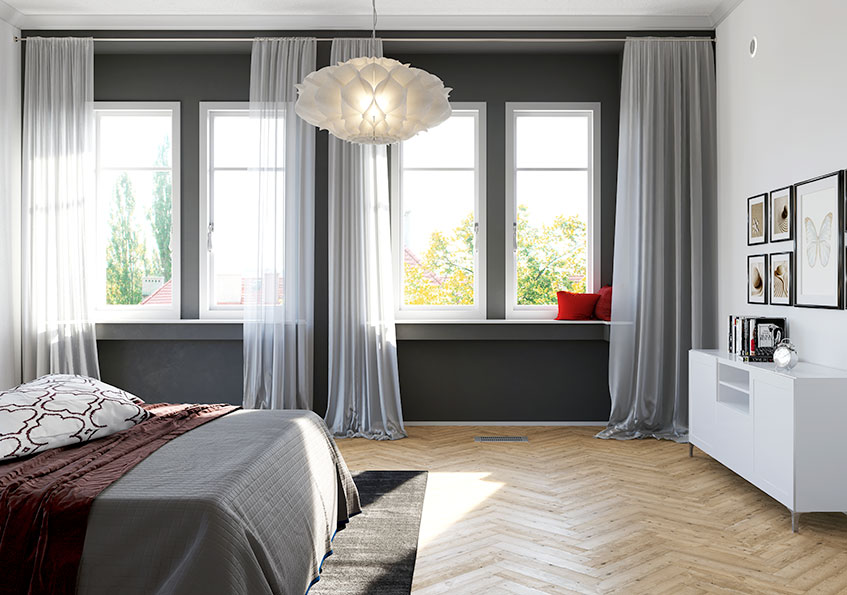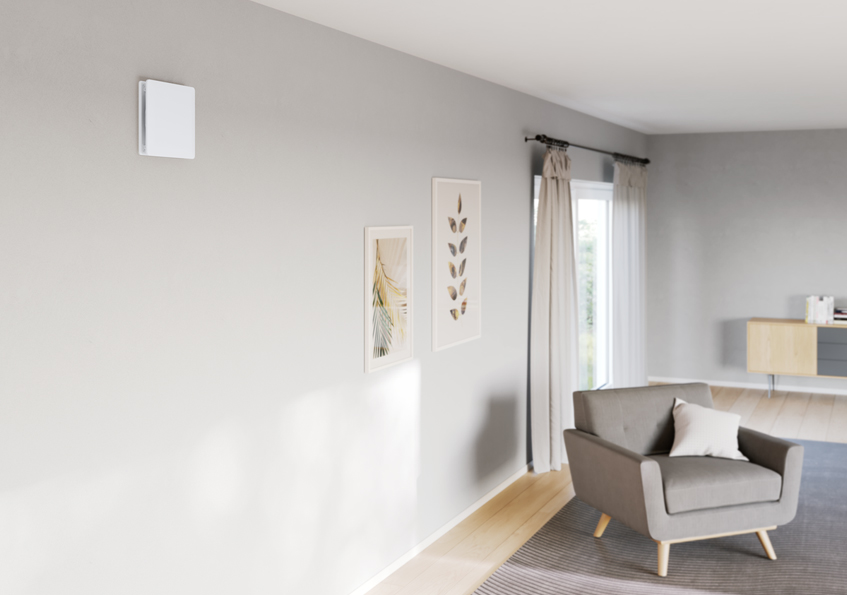Ventilation systems
-
Convenience is in the air
Leave your mechanical ventilation system to ventilate your living space. All you have to do is relax and enjoy fresh, filtered indoor air and a comfortable temperature. Our ventilation systems ensure that you really can breathe easily at home. Your ventilation unit noticeably improves the indoor air and your quality of life, with minimal disruption.
Draughts and wasted energy caused by window ventilation, along with the loss of over 50 percent of heating energy, are a thing of the past. Our ventilation units work automatically, quietly and inconspicuously to ensure the necessary air changes. Some people still think that ventilation systems are too large or expensive for their homes. But with our compact units and the subsidies available, there are no drawbacks, just benefits – pleasant fresh air in your living space and especially efficient operation.Good reasons to enjoy your home comforts
Comfort through ventilation systems
Benefits for your home
A comfortable atmosphere: the result of good indoor air
What affects our room climate? First, of course, there is the weather: summer heat, dry cold, humid conditions. Fine dust and pollen can get into your home when you open the windows. And you, too, have an impact. After all, you breathe, cook, clean and shower, exhaling carbon dioxide into the indoor air, creating an abundance of scents and smells, and emitting heat and water vapour. A three-person household emits up to ten litres of water per day in the form of water vapour into the indoor air. And emissions from building materials, furniture and floors can also have a negative impact on your indoor air.
Perhaps you like to linger in the bath, sleep in late or cook three-course meals? Your ventilation system ensures good, healthy air in your home at all times. The logical consequence is that the air must be replaced regularly. If it is not, the oxygen content of the air drops while the amount of CO2 and harmful substances it contains increases. And excessive concentration of carbon dioxide in indoor air has been shown to cause discomfort, as well as to negatively affect cognitive performance. And none of us want that... the solution is a ventilation system that works fully automatically to ensure greater living comfort and a better atmosphere in your home!
Here’s all you see of your new ventilation system in your living room and bathroom
![]()
The LA 70 decentralised ventilation unit is suitable for ventilation all extract air areas with an external wall and can be used for different safety zones in sanitary facilities. ![Ventilation system in the living room]()
Ventilation system in the living room: with its simple design, the cover of the decentralised ventilation system VLR 70 Trend blends perfectly into any surroundings. ![Ventilation system in the bathroom]()
Ventilation system in the bathroom: the LWZ 130 central ventilation system is hidden in your ceiling. Even though you can’t see it, you still enjoy clean and filtered indoor air. ![Ventilation system in the utility room]()
In your utility room: our LWZ integral units have a particularly compact design. With a footprint of around one square metre, they ensure not only fresh air but also cosy heat and hot water thanks to an air source heat pump and cylinder. Are you a professional?Our services
Breathe easily
Thanks to high grade filters, the quality of your indoor air is always excellent. You can choose between a variety of filter classes, including pollen and fine dust filters. Everyone breathes easily – allergy sufferers too. The filter change frequency is based on the level of use. Filters that are used intensively in your kitchen or in a room overlooking a busy road will need more frequent replacement.
Filter change tips
We recommend that you change the filters several times a year to enjoy consistently high air quality. The video below shows you how to replace the filters in your VLR 70 ventilation system. Suitable spare filters and filter sets for your ventilation system can be sourced from our partners.
Benefits for your home
- Discover high grade filters for even better indoor air quality
- We offer you a broad variety of filter classes
- Reduce fine dust and pollen
- High dust holding capacity
Explained in briefHow does a ventilation system work?
We offer both central and decentralised ventilation systems. Read on to find out how each type works.
How a decentralised ventilation system works
When it comes to ventilation systems, we differentiate between decentralised and central units. An air distribution system is not needed for decentralised systems. They are therefore especially suitable for retrofitting in a modernisation project. We offer systems with and without heat recovery: in the case of decentralised systems with heat recovery, your installer puts a single unit in the external wall of each room to be ventilated. This may involve systems with two fans and heat recovery via a countercurrent heat exchanger, for example.
Moreover, you can use units also known as reversible fans. These are always installed in pairs and run alternately so that no underpressure or overpressure is created in the room. If required, you can operate up to eight ventilation units by means of one control unit and one programming unit. Through regenerative heat transfer, the high quality aluminium heat exchanger is charged with heating energy from the extract air. The EC fan changes direction after 40 seconds and blows fresh air from the outside into the room. As this happens, the previously absorbed heating energy is transferred to the supply air. This reduces heating energy loss by up to 93 percent.
How central ventilation systems work
Central solutions used in new build or comprehensive modernisation projects are available as extract air systems and as supply/extract air systems. These require ventilation ducts that are let into walls, concrete ceilings, suspended ceilings, the floor, placed under a screed layer, or even kept visible. An extract air system extracts stale air via ductwork from the extract air areas, such as the kitchen, bathroom and toilet. At the same time, fresh air is drawn through outdoor air apertures directly into the supply air areas (living room, play room, bedrooms). The volume of air extracted from the extract air areas is determined by the fan rate.
A supply/extract air system draws the outdoor air from a central point and distributes it by means of ductwork throughout the supply air areas. Heat is recovered in a cross-countercurrent heat exchanger, which transfers up to around 90 percent of the latent heat in the extract air to the supply air. The outdoor air is filtered to prevent contamination of the unit and ductwork, and to protect allergy sufferers against the effects of dust and pollen.
![LWZ 180 ventilation system from STIEBEL ELTRON]()
LWZ 180/280 central ventilation systems are a good choice for apartments, detached houses and commercial properties of up to approx. 170/250 square metres. Tip: if your indoor air is very dry, an enthalpy heat exchanger will help. ![LWZ 8 CS Premium ventilation system from STIEBEL ELTRON]()
The LWZ 8 CS Premium central integral ventilation unit offers every comfort and convenience worthy of an energy efficient house. It reliably takes care of your living comfort, with ventilation, room heating, DHW heating and cooling functions. Moreover, some ventilation systems with heat recovery can include an enthalpy heat exchanger. This not only recovers the latent heat from the extract air, but also some of the moisture, and transfers these to the supply air. In conventional heat exchangers, the air streams are routed separately past each other through extremely thin plastic or aluminium walls. The heating energy flows automatically from the warm exhaust air to the cold supply air. Enthalpy heat exchangers use a permeable membrane – that allows even water vapour to pass – between the air streams. This transfer also takes place automatically as soon as dry air and “humid” air are routed past each other on either side of the membrane.
Downloads
Compact knowledge. Our ventilation system brochures
Central ventilation system brochure





